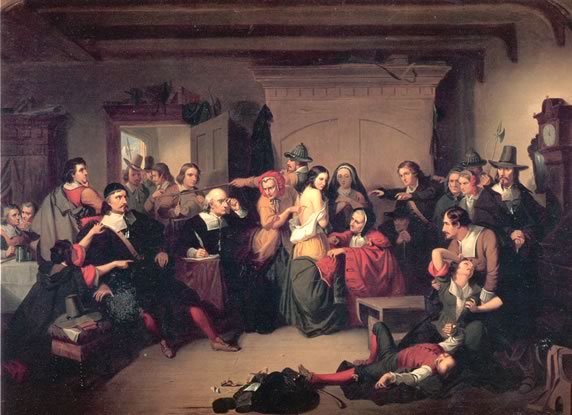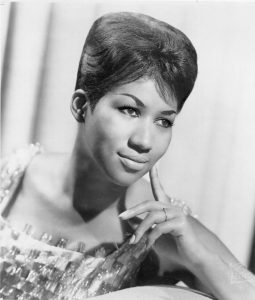Why would adults in Salem, Massachusetts in the 1690s take the accusations of nine year old girls seriously? During the seventeenth century, New England had grown diverse. The people living in the communities were of different backgrounds. But in the 1690’s there was an apparent outbreak of witchcraft. The most famous of these outbreaks was the event in Salem, Massachusetts in 1692 that stirred up the Salem community and soon spread to other communities.
The widespread hysteria over witches was all over the town after an accusation of witchcraft was made in January 1692. A group of young adolescent girls met in the home of Samuel Parris, a Puritan pastor in Salem. The pastor had a nine year old daughter, Betty. Betty and her cousin Abigail were fascinated by the voodoo tales and tricks told to them by the family slave. The family slave, Tituba, was the one whom the little girls had sought after for entertainment.1 It was not long after their time spent with Tituba, when the girls began to behave strangely; seeing visions, babbling at times, and lapsing into trances. The Puritans thought that these behaviors were of witchcraft, as the work of the devil. People in Salem began believing the girls, and charged Tituba and two other village women for practicing witchcraft on them. Two men, John Hathorne and Johnathan Corwin of Massachusetts, were called to do a legal examination of the women. The Puritans followed the Old Testament law. This was how they assessed the examinations. Scripture had a statement that said witches were not able to live. The two men knew exactly what they had to do. The examination was done on these women of Salem by looking for a certain mark on the body: a wart or tit. This specific mark was said to be the place where the devil and his demons would take blood out of the witch.2 Many of the women accused were of lower status in the community.

Research shows most of the accused witches were middle-aged women, widowed, with few or no children. Also, if the woman had been involved with domestic conflicts, they were accused. The women were accused of crimes and appeared to be dangerous by their neighbors. Women in Salem who inherited or possessed land were also accused of witchcraft.3 The accusations towards these women were out of the ordinary and seemingly wrong. One must first think about the view of women during this time. They were undermined and portrayed as having no power or knowledge of such things; they were subservient to the men in the community. Not only were low class women accused of witchcraft, but as time passed, superior women were accused as well.4
On October 29th, the Salem Witch Trials were called to an end. Governor Phips dismissed the Court and that marked the end to the witch hunt craze. Many were disappointed about the ending of the trials, but many were glad to return to work.5 The community in Salem blamed Pastor Parris for letting the innocent die. The people of the Salem church also voted to void his salary. In the following years, those family members of the deceased were restored their good names. The families were awarded a compensation for all the financial loses they went through during such tragic times. Increase Mather, a pastor of the Boston Puritan Church, wanted the people to do away with the court because he believed they put innocent people to death.
The Witch trials took on an important role in American History. The trials became a tragic and memorable moment in history. Generational, racial, and sexual hostility, opposition to law, social stresses, and food poisoning were all causes as to why the people had anxieties that found release in the witch hunt craze. The witch hunts became searches for scapegoats; the community leaders were looking for anyway possible to ease the community’s anxieties.6
- Kenneth P. Minkema, “In the Devil’s Snare: The Salem Witchcraft Crisis of 1692,” The Christian Century, no. 8 (2003): 37. ↵
- Salem Press Encyclopedia, January 2015, s.v. “Salem Witchcraft Trials,” by Warren M. Billings and Kimberly Manning. ↵
- Alan Brinkley, American History, 15th ed., vol. 1: to 1865 (2 Penn Plaza, New York, NY 10121: McGraw Hill Education, 2015), 86-87. ↵
- Salem Press Encyclopedia, January 2015 s.v. “Salem Witchcraft Trials,” by Warren M. Billings, Kimberly Manning. ↵
- Salem Press Encyclopedia, January 2015 s.v. “Salem Witchcraft Trials,” by Warren M. Billings, Kimberly Manning. ↵
- Salem Press Encyclopedia, January 2015 s.v. “Salem Witchcraft Trials,” by Warren M. Billings and Kimberly Manning. ↵



178 comments
Michelle Falcon
Hocus Pocus was one of my favorite movies growing up. However the movie is very different from this article, it still deals with witchcraft. This article tells about some of the first witchcraft attacks in Salem. It continues one telling the readers how lower class woman were considered witches but as time went on puritan women were also accused. This was over all an amazing article that I very much so enjoyed reading.
Auroara-Juhl Nikkels
The Salem Witch Trials is one of the times in history that has always fascinated me. I love to learn about this topic and your article allowed me to learn just a bit more. Previously, I didn’t know that this started over a nine year old girl. I have to wonder why the girls weren’t accused of witchcraft, just the older lady was and why only women were accused.
Samuel Sanchez
Amazing article on such tragic time in history. It is sad how the trials had began because of two little girls. It is astonishing how much of an impact they have and because of it innocent people died. Anyone could have been accused. People probably made up accusations to get back at some one and of course there was no real solution to prove the accusation wrong. Great job on the background of the trials. Very interesting, keep up the good work.
Mario De Leon
This article was very interesting! It gave a good brief explanation as to what happen in Salem in 1692. I found it interesting that most of the accused women were from the middle class and tended to be widowed with no children. I liked how the author explained how the Salem witch trials were important to American history at the end.
Gabriela Medrano
Interesting topic, reading about witches never gets old! It is unbelievable that small factors like these two girls can cause so much damage to small town folks. I was not aware of the restorations made in the aftermath of the trials. At the very least, people gave back some of what was taken from families who suffered deaths and accusations, that was a cool fact I was not aware of. Also, the mark? I did not know they looked for a mark usually in all the hysteria one assumes people were chosen at random. Cool article!
Nahim Rancharan
Although the Salem Witch Trials are highly publicized in movies, TV shows and novels, it really takes away from the harsh reality that the people during this time had to endure. Although there may be some claim to the practice of witchcraft during this time, the Salem Trials was, for the most part, used as a way for people to get rid of lower class members of society and people that they disapproved of. Many innocent people suffered under the Salem Witch Trials and this article does a great job at highlighting this truth of American History that has been either downplayed or forgotten. Good Work!
Cesar Zavala
The Salem Witch trials seem like something straight out of a movie. To know that these monstrosities did in fact occur in our country’s history is shocking and hard to believe. It seems that it got to a point where women were accused of witchcraft for any little reason. Overall, very well written article with information that isn’t commonly known by the majority of people.
Oscar Portillo
If the witch hunt craze began over two little girls, then there was something wrong with the people of this time. However, I see why some people would do such atrocious acts based on a hunch. For example, some Latin American countries still tell of urban legends such the wailing woman and the Chupacabra. Thus, they are cautious of what time of day they will be outside and their behavior in general. In essence, people usually let their imaginations get the best of them and that might explain why the Salem Witch trials occurred. Good article and a tragic event of our history hopefully never to be repeated again.
Elizabeth Garibay
This title really caught my attention! I enjoyed reading this article because its interesting and it’s a topic you do not hear much about. I never thought witchcraft would be part of history! It’s crazy what the witches would do. It was crazy to read that the Pastor was blamed for putting these innocent women to death because of their involvement with witchcraft. Overall it was very interesting.
Anayeli Prieto
i noticed in your story that you mention the women as being the only who were acused and convicted for whitchcraf. I read the Book the Crucible by Arthur Miller and it also mentioned that many of the men who acused others of whitchcraft when attempting to gain more land. They felt that it might of been simpler to acuse each other of witchcraft, than to fight for territory or any belongings that they wished to have. It was very strange and unfortunate however that they belived a nine year old girl who, as mentioned in The Crucible, only used the excuse of Witchcraft as an excuse to separate a married couple. I really admired your detailed description of what was occurring in the Salem Witch Trails.